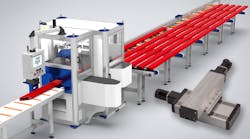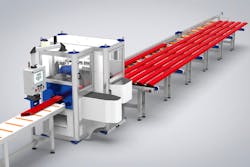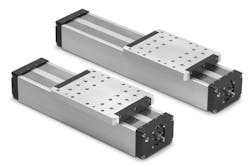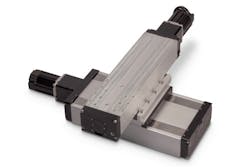Automation Streamlines the Window-Making Process
A large part of the business at the DeMichele Group (DMG) in Chandler, Ariz. revolves around designing and building industrial fabrication hardware and software for the glazing or window-making industry. Engineers there were recently tasked with automating the extrusion and assembly of linear components into windows for storefronts and curtain walls, as well as window accessories. The equipment also had to be compact to move and work at construction sites to speed installation.
Glazing contractors must work quickly, accurately, and safely at building sites to properly manufacture components, assemble them, and then install window frame facings, curtain walls and storefronts in multi-story commercial buildings. But if holes drilled in extruded metal parts are misplaced or not correctly cut to size, there can be problems. And if there are similar problems with too many parts, construction slows and projects go over budget. All it takes are misplaced quarter-inch holes.
One part of the process called for a CNC machine that could automatically pre-drill holes and cut-to-length the window components, which are usually made of extruded aluminum. These had to be done precisely and the CNC machinery had to be stable. Otherwise, holes could be inaccurately positioned, or parts cut too long or too short, which ruins the fit and finish of the final assembly.
The aluminum framing also cannot deflect or bend, a common problem when machining with high-CNC speed drills and routers. As the material moves through the machine, the cutting axis may bite, bend, or become unstable. If the actuator holding the drill, for example, doesn’t properly hold it tightly or withstand the force of the press, it will misplace or incorrectly cut the hole(s). The pace of production then slows until the inaccuracies are scrapped and re-machined.
“The DMG engineering team started developing a new CNC machine with some readily available actuators on the market,” recalls Brian Hefner, DMG president. “But they weren’t rigid enough to properly hold the needed tolerances, plus they let particulates get inside of them where they caused problems. So, we started R&D to investigate ways to resolve these issues. We also teamed up with Tolomatic, a company with expertise in electric actuators, and developed a custom actuator with the rigidity and protective sealing the application needed.”
The challenge was to create a multi-axis CNC system that can push, pull and position the drill accurately. “It’s easy enough to apply force and pressure for a single-axis system,” says Igor Glikin, Tolomatic engineer. “But when pushing a force on a multi-axis system, it can make the system unstable if not designed properly.”
There were two problems to solve: providing enough bearing capacity to take the payload; and protecting the actuator against metal shavings and other particles from getting in.
“We created our linear actuator body out of a material with high rigidity and significant moments of inertia in mind and used FEA to calculate how much bending force would be created and if it would cause too much deflection,” says Glikin. “The goal was to make the deflection as small as possible under the required moment or force while getting the actuators to fit inside a small envelope and hitting the cost target.”
“A new Twin profile Rail Stage (TRS) rodless screw-driven actuator solved those two issues,” explains Andy Zaske, Tolomatic vice president. “The rigid aluminum single-body actuator prevents deflection and ensures a perfect cut every time. And the actuator’s flat carriage and sealed band components were critical in preventing metallic shavings created by the drilling and cutting process from getting inside the unit.”
“Tolomatic also has a long history of designing top-notch band sealing actuators that dates back to our pneumatic rodless cylinder roots,” said Zaske. “Band sealing technology let us create a much more robust seal which ensures a long, uninterrupted life.”
The final actuators could carry loads up to 1,249 lb (6.0 kN) and the TRS multi-axis (XY) systems mount carrier-to-carrier with no additional mounting plates.
The final CNC machine, the 9-axis RhinoFab, moves three XYZ systems with three actuators each. There are nine different axis points on each RhinoFab: three on the top, bottom, and front. Each XYZ system can accommodate up to three different tool sets to fabricate the storefront and curtainwall window materials. The RhinoFab CNC can create? machine extrusions from the top and bottom at the same time. There can also be another actuator for a cut-off saw for making 90-deg. up- or down-cuts to get the component to the required length. Then the part moves out of the fab center and is readied for installation.
During the machining process, the DMG software determines the precise position and number of holes or patterns required on a given length of aluminum facing. The part is automatically moved into position and the three-axis linear actuator CNC machine drills and routes the top, bottom, and front.
“The TRS actuator design started out as a custom product for a specific application,” says Zaske. “Tolomatic has a history of innovating with customers and then using that new concept to launch products that balance engineering designs and customer needs.”
The actuators can be used for any application requiring one, two or three axis configurations, such as machining centers, laser positioning, collaborative robot movement, pick-and-place and material handling.
According to DMG President Brian Hefner, the new machine provides a lot of opportunities for smaller firms. “The machine’s faster throughput gives smaller companies an economical, automated process, which lets them get the most out of their manual labor while letting them bid on larger jobs. What used to be a complex and expensive process is now much more widely available.”
The 9-axis machine has been so successful that DMG has continued to expand its offering of machining centers to include 11- and 13-axis systems, as well as introduce another line of even more rigid and robust TRS actuators for their largest and most rugged systems.



